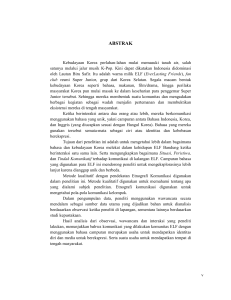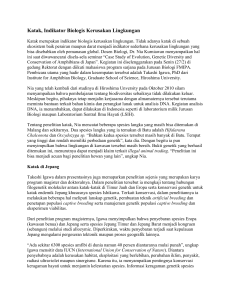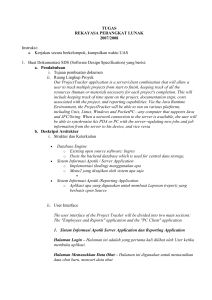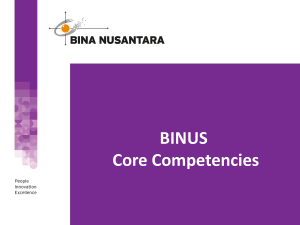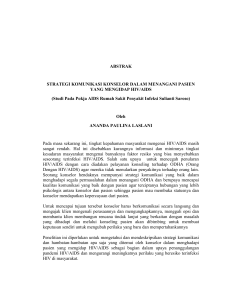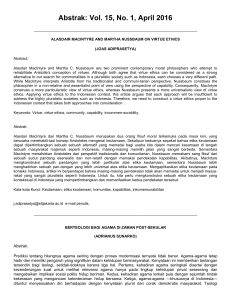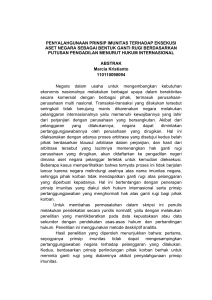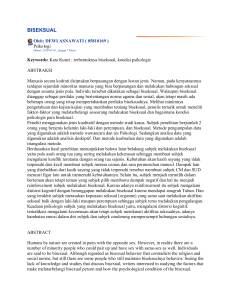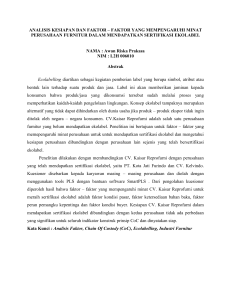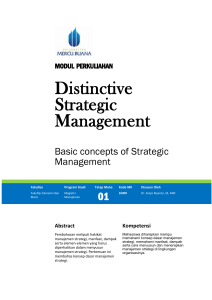21 Juni 20081. BACKGROUND
advertisement
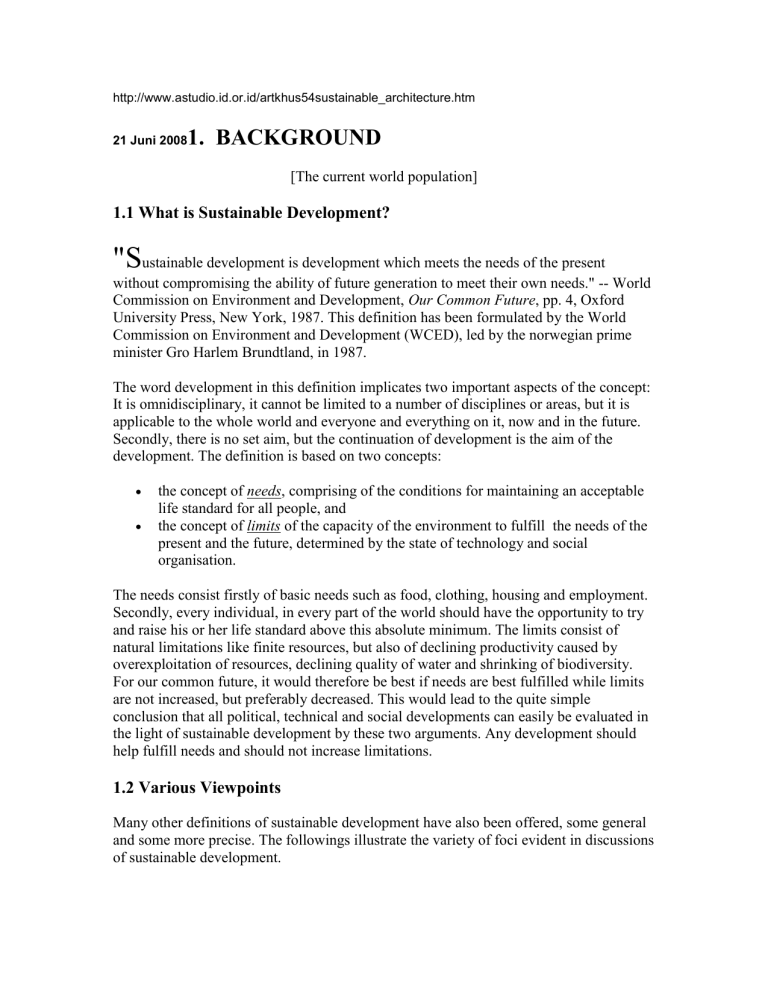
http://www.astudio.id.or.id/artkhus54sustainable_architecture.htm 21 Juni 2008 1. BACKGROUND [The current world population] 1.1 What is Sustainable Development? "Sustainable development is development which meets the needs of the present without compromising the ability of future generation to meet their own needs." -- World Commission on Environment and Development, Our Common Future, pp. 4, Oxford University Press, New York, 1987. This definition has been formulated by the World Commission on Environment and Development (WCED), led by the norwegian prime minister Gro Harlem Brundtland, in 1987. The word development in this definition implicates two important aspects of the concept: It is omnidisciplinary, it cannot be limited to a number of disciplines or areas, but it is applicable to the whole world and everyone and everything on it, now and in the future. Secondly, there is no set aim, but the continuation of development is the aim of the development. The definition is based on two concepts: the concept of needs, comprising of the conditions for maintaining an acceptable life standard for all people, and the concept of limits of the capacity of the environment to fulfill the needs of the present and the future, determined by the state of technology and social organisation. The needs consist firstly of basic needs such as food, clothing, housing and employment. Secondly, every individual, in every part of the world should have the opportunity to try and raise his or her life standard above this absolute minimum. The limits consist of natural limitations like finite resources, but also of declining productivity caused by overexploitation of resources, declining quality of water and shrinking of biodiversity. For our common future, it would therefore be best if needs are best fulfilled while limits are not increased, but preferably decreased. This would lead to the quite simple conclusion that all political, technical and social developments can easily be evaluated in the light of sustainable development by these two arguments. Any development should help fulfill needs and should not increase limitations. 1.2 Various Viewpoints Many other definitions of sustainable development have also been offered, some general and some more precise. The followings illustrate the variety of foci evident in discussions of sustainable development. ". . . requires meeting the basic needs of all people and extending opportunities for economic and social advancement. Finally, the term also implies the capacity of development projects to endure organizationally and financially. A development initiative is considered sustainable if, in addition to protecting the environment and creating opportunity, it is able to carry out activities and generate its own financial resources after donor contributions have run out." Bread for the World, Background Paper No. 129, Washington, DC, March 1993. "[improves] . . . the quality of human life while living within the carrying capacity of supporting ecosystems." International Union for the Conservation of Nature and Natural Resources (IUCN), World Conservation Union, United Nation Environment Programme (UNEP), and World Wide Fund for Nature (WWF), Caring for the Earth, pp. 10, IUCN/UNEP/WWF, Gland, Switzerland, 1991. "[uses] . . . natural renewable resources in a manner that does not eliminate or degrade them or otherwise dimish their renewable usefulness for future generations while maintaining effectively constant or non-declining stocks of natural resources such as soil, groundwater, and biomass." World Resources Institute, Dimensions of sustainable development, World Resources 1992-93: A Guide to the Global Environment, pp. 2, Oxford University Press, New York, 1992. "[maximizes] . . . the net benefits of economic development, subject to maintaining the services and quality of natural resources." R. Goodland and G. Ledec, Neoclassical economics and principles of sustainable development, Ecological Modeling 38 (1987): 36. "[is based on the premise that] . . . current decisions should not impair the prospects for maintaining or improving future living standards . . . This implies that our economic systems should be managed so that we live off the dividend of our resources, maintaining and improving the asset base." R. Repetto, World Enough and Time, pp. 15-16, Yale University Press, New Haven, CT, 1986. " . . . is taken to mean a positive rate of change in the quality of life of people, based on a system that permits this positive rate of change to be maintained indefinitely." L. M. Eisgruber, Sustainable development, ethics, and the Endangered Species Act, Choices, Third Quarter 1993, pp. 4-8. " . . . is development without growth --- a physically steady-state economy that may continue to develop greater capacity to satisfy human wants by increasing the efficiency of resource use, but not by increasing resource throughput." H. E. Daly, Steady state economics: concepts, questions, and politics, Ecological Economics 6 (1992): 333-338. " . . . is the search and the carrying out of rational strategies that allow society to manage, in equilibrium and perpetuity, its interaction with the natural system (biotic/abiotic) such that society, as a whole, benefits and the natural system keeps a level that permits its recuperation." E. Gutierrez-Espeleta, Indicadores de sostenibilidad: instrumentos para la evaluacion de las politicas nacionales", unpublished paper presented at 50th Anniversity Conference of the Economic Sciences Faculty sponsored by the University of Costa Rica, San Jose, Costa Rica, Nov. 19, 1993. "Future generation is the most important" --- Confucius. "Treat the Earth well. It was not given to you by your parents. It was loaned to you by your children." --- Kenyan Proverb. "Sustainability is living on the interest rather than the principle." -- economics educators. Sustainability (Nachhaltigkeit) as postulated in Germany "requires the inextricable linkage of ecology, economy and social security. Sustainable development requires that improvements in economic and social living conditions accord with the long-term process of securing the natural foundations of life (G1)". A sustainable system delivers services without exhausting resources. It uses all resources efficiently both in an environmental and economic sense. 1.3 Three Dimensions Economic dimensions of sustainability: Creation of new markets and opportunities for sales growth Cost reduction through Environmental dimensions of sustainability Reduced waste, effluent generation, emissions to environment Social dimensions of sustainability Worker health and safety Impacts on local efficiency improvements and reduced energy and raw material inputs Creation of additional added value Reduced impact on human health Use of renewable raw materials Elimination of toxic substances communities, quality of life Benefits to disadvantaged groups e.g. disabled Environmental Sustainability The idea of environmental sustainability is to leave the Earth in as good or better shape for future generations than we found it for ourselves. By a definition, human activity is only environmentally sustainable when it can be performed or maintained indefinitely without depleting natural resources or degrading the natural environment. Resource consumption would be minimal Materials consumed would be made ENTIRELY of 100% post-consumer recycled materials or from renewable resources (which were harvested without harm to the environment and without depletion of the resource base) Recycling of waste streams would be 100% Energy would be conserved and energy supplies would be ENTIRELY renewable and non-polluting (solar thermal and electric, wind power, biomass, etc.) 1.4 Further Reading Definition of Sustainability [AGS] Definitions of Sustainability [SDIC] The Economics of Sustainability [US-EPA] Global Sustainability Concepts [University of California Irvine] Interactive Learning About Sustainable Development [IISD] Sustainable Development: Education for Engineers & Others Sustainable Development Information [Five E's] "Sustainability" by Robert Gilman, from the 1992 UIA/AIA "Call for Sustainable Community Solutions" [Context Institute] Sustainability and Sustainable Development [University of Reading, UK] Thoughts on Sustainability [eDesign] What is sustainable development? [SustainAbility.com] What is "Sustainability"? [Florida Sustainable Communities Center] What is Sustainability? [US EPA] What Is Sustainability? [by Susan Murcott of MIT] o Definitions o Principles o Criteria o Indicators o Conceptual Frameworks 2. CONCEPTS "Architecture presents a unique challenge in the field of sustainability. Construction projects typically consume large amounts of materials, produce tons of waste, and often involve weighing the preservation of buildings that have historical significance against the desire for the development of newer, more modern designs." -- The Earth Pledge (www.earthpledge.org) 2.1 Sustainable Construction Sustainable construction is defined as "the creation and responsible management of a healthy built environment based on resource efficient and ecological principles". Sustainably designed buildings aim to lessen their impact on our environment through energy and resource efficiency. It includes the following principles: minimising non-renewable resource consumption enhancing the natural environment eliminating or minimising the use of toxins Accordning to an OECD Project, "Sustainable building" can be defined as those buildings that have minimum adverse impacts on the built and natural environment, in terms of the buildings themselves, their immediate surroundings and the broader regional and global setting. "Sustainable building" may be defined as building practices, which strive for integral quality (including economic, social and environmental performance) in a very broad way. Thus, the rational use of natural resources and appropriate management of the building stock will contribute to saving scarce resources, reducing energy consumption (energy conservation), and improving environmental quality. Sustainable building involves considering the entire life cycle of buildings, taking environmental quality, functional quality and future values into account. In the past, attention has been primarily focused on the size of the building stock in many countries. Quality issues have hardly played a significant role. However, in strict quantity terms, the building and housing market is now saturated in most countries, and the demand for quality is growing in importance. Accordingly, policies that contribute to the sustainability of building practices should be implemented, with recognition of the importance of existing market conditions. Both the environmental initiatives of the construction sector and the demands of users are key factors in the market. Governments will be able to give a considerable impulse to sustainable buildings by encouraging these developments. The OECD project has identified five objectives for sustainable buildings: Resource Efficiency Energy Efficiency (including Greenhouse Gas Emissions Reduction) Pollution Prevention (including Indoor Air Quality and Noise Abatement) Harmonisation with Environment (including Environmental Assessment) Theme Integrated and Systemic Approaches (including Environmental Management System) Environmental Economic Social Sub-theme - Global - Local and site - Internal - Construction - Materials - Infrastructure - Equity - Community Issues - Profitability - Employment - Productivity - Transport and utilities - Building stock value - Poverty - Minorities - Inner cities - Transport - Communications - Climate change - Resources - Internal environment - External environment - Wildlife Green Code for Architecture [From: Greening Government: Towards More Sustainable Construction: Green Guide for Managers on the Government Estate, Department for Environment, Food & Rural Affairs, UK] Based on the objectives of the Building Research Establishment's Environmental Assessment Method (BREEAM) The principles are: demolish and rebuild only when it is not economical or practicable to reuse, adapt or extend an existing structure; reduce the need for transport during demolition, refurbishment and construction and tightly control all processes to reduce noise, dust, vibration, pollution and waste; make the most of the site, eg. by studying its history and purpose, local microclimates and the prevailing winds and weather patterns, solar orientation, provision of public transport and the form of surrounding buildings; design the building to minimise the cost of ownership and its impact on the environment over its life span by making it easily maintainable and by incorporating techniques and technologies for conserving energy and water and reducing emissions to land, water and air; wherever feasible, use the construction techniques which are indigenous to the area, learning from local traditions in materials and design; put the function of the building and the comfort of its occupants well before any statement it is intended to make about the owner or its designer. That is, make it secure, flexible and adaptable (to meet future requirements) and able to facilitate and promote communications between staff; build to the appropriate quality and to last. Longevity depends much on form, finishes and the method of assembly employed as on the material used. avoid using materials from non renewable sources or which cannot be reused or recycled, especially in structures which have a short life; 2.2 Environmental Architecture Five principles of an environmental architecture (Thomas A. Fisher, AIA, November, 1992): Healthful Interior Environment. All possible measures are to be taken to ensure that materials and building systems do not emit toxic substances and gasses into the interior atmosphere. Additional measures are to be taken to clean and revitalize interior air with filtration and plantings. Energy Efficiency. All possible measures are to be taken to ensure that the building's use of energy is minimal. Cooling, heating and lighting systems are to use methods and products that conserve or eliminate energy use. Ecologically Benign Materials. All possible measures are to be taken to use building materials and products that minimize destruction of the global environment. Wood is to be selected based on non destructive forestry practices. Other materials and products are to be considered based on the toxic waste out put of production. Environmental Form. All possible measures are to be taken to relate the form and plan of the design to the site, the region and the climate. Measures are to be taken to "heal" and augment the ecology of the site. Accomodations are to be made for recycling and energy efficiency. Measures are to be taken to relate the form of building to a harmonious relationship between the inhabitants and nature. Good Design. All possible measures are to be taken to achieve an efficient, long lasting and elegant relationship of use areas, circulation, building form, mechanical systems and construction technology. Symbolic relationships with appropriate history, the Earth and spiritual principles are to be searched for and expressed. Finished buildings shall be well built, easy to use and beautiful. Architect William McDonough defined the breadth of what Green Building is: The Hannover Principles Living buildings will: Harvest all their own water and energy needs on site. Be adapted specifically to site and climate and evolve as conditions change. Operate pollution-free and generate no wastes that aren't useful for some other process in the building or immediate environment. Promote the health and well-being of all inhabitants, as a healthy ecosystem does. Be comprise of integrated systems that maximize efficiency and comfort. Improve the health and diversity of the local ecosystem rather than degrade it. Be beautiful and inspire us to dream. -- Jason F. McLennan, BNIM Architects 2.3 Ecological Building Ecology Ecological Building 1. the science of the relationship and interaction of living organisms with their inanimate (e.g. climate, soil) and their animate environment, as well as the study of resource and energy management in the biosphere and its sub-categories. 2. the study of the detrimental effects of modern civilization on the environment, with a view toward prevention or reversal through conservation. A movement in contemporary architecture. This movement aims to create environmentally friendly, energy-efficient buildings and developments by effectively managing natural resources. This entails passively and actively harnessing solar energy and using materials which, in their manufacture, application, and disposal, do the least possible damage to the socalled 'free resources' water, ground, and air. Economy 1. careful, thrifty management of resources, such as money, materials, or labor. 2. an orderly, functional arrangement of parts; on organized system. 3. efficient, sparing, or conservative use. Major Areas: Environment Building Fabric Building Technology Air Free air - Natural ventilation - Wind force - Energy content Stack effect - Solar energy, diffuse radiation - Solar energy, direct radiation Facade and roof Transparent insulating material Photovoltaics Absorber surface Storage masses Planted surfaces Rainwater Dayligth elements Collectors Cooling energy Direct - Electrically driven chiller - Absorption chiller - Gas-motor driven chiller - Cooling towers - Tandem systems Indirect - Cold storage in building - Cold storage in terrain - Bore holes Soil Aquifer - Heat storage - Cool storage Groundwater Construction Storage masses Passive solar absorber Heat exchanger elements Night cooling by outside Heat energy Direct - District heating - Boiler (gas, oil, coal, biogas, condensing) - Cold energy - Heat energy Earth/rock - Geothermal cooling - Heat energy Water surfaces Lake - Pump water or greywater - Heat energy - Cold energy River - Pump water or greywater - Heat energy - Cold energy Sea - Pump water or greywater - Heat energy - Cold energy air Atria Green zones Evaporative cooling Passive solar energy Heat buffer - Electric boiler (with storage) Indirect - Solar thermal system - Combined heat and power (CHP) - Heat pumps - Flue gas heat exchanger Electrical energy Mains supply - Commercial power supply utilities Self supply - Combined heat and power (CHP) - Emergency generator - Photovoltaics - Tandem system - Wind energy generator Water Pure water - Public supply (drinking, cooking) Greywater - Waste water (condenser water, flushing, cleaning) Rainwater - Flushing, cleaning, cooling What does "Ecos" mean? 2.4 Green Building "It's not easy being green." -- Kermit the Frog, 1972. A green approach to the built environment involves a holistic approach to the design of buildings. All the resources that go into a building, be they materials, fuels or the contribution of the users need to be considered if a sustainable architecture is to be produced. Producing green buildings involves resolving many conflicting issues and requirements. Each design decision has environmental implications. Measures for green buildings can be divided into four areas: reducing energy in use minimising external pollution and environmental damage reducing embodied energy and resource depletion minimising internal pollution and damage to health What Makes a Building Green? A "green" building places a high priority on health, environmental and resource conservation performance over its life-cycle. These new priorities expand and complement the classical building design concerns: economy, utility, durability, and delight. Green design emphasizes a number of new environmental, resource and occupant health concerns: Reduce human exposure to noxious materials. Conserve non-renewable energy and scarce materials. Minimize life-cycle ecological impact of energy and materials used. Use renewable energy and materials that are sustainably harvested. Protect and restore local air, water, soils, flora and fauna. Support pedestrians, bicycles, mass transit and other alternatives to fossil-fueled vehicles. Most green buildings are high-quality buildings; they last longer, cost less to operate and maintain, and provide greater occupant satisfaction than standard developments. Sophisticated buyers and lessors prefer them, and are often willing to pay a premium for their advantages. What surprises many people unfamiliar with this design movement is that good green buildings often cost little or no more to build than conventional designs. Commitment to better performance, close teamwork throughout the design process, openness to new approaches, and information on how these are best applied are more important than a large construction budget. Sustainable Design Sustainable design is the thoughtful integration of architecture with electrical, mechanical, and structural engineering. In addition to concern for the traditional aesthetics of massing, proportion, scale, texture, shadow, and light, the facility design team needs to be concerned with long term costs: environmental, economic, and human. The Rocky Mountain Institute outlines five elements for sustainable design: Planning and design should be thorough. Sustainable design is "front loaded" compared with traditional design. Early decisions have the greatest impact on energy efficiency, passive solar design, daylighting, and natural cooling. Sustainable design is more of a philosophy of building than a prescriptive building style. Sustainable buildings don't have any particular look or style. Sustainable buildings don't have to cost more, nor are they more complicated than traditional construction. Integrated design, that is design where each component is considered part of a greater whole, is critical to successful sustainable design. Minimizing energy consumption and promoting human health should be the organizing principles of sustainable design. The other elements of design can be organized: energy saving architectural features, energy conserving building envelope, and energy-efficient and health-promoting mechanical, electrical, and plumbing systems. Principles of Sustainable Design Understanding Place - Sustainable design begins with an intimate understanding of place. If we are sensitive to the nuances of place, we can inhabit without destroying it. Understanding place helps determine design practices such as solar orientation of a building on the site, preservation of the natural environment, and access to public transportation. Connecting with Nature - Whether the design site is a building in the inner city or in a more natural setting, connecting with nature brings the designed environment back to life. Effective design helps inform us of our place within nature. Understanding Natural Processes - In nature there is not waste. The byproduct of one organism becomes the food for another. In other words, natural systems are made of closed loops. By working with living processes, we respect the needs of all species. Engaging processes that regenerate rather than deplete, we become more alive. Making natural cycles and processes visible brings the designed environment back to life. Understanding Environmental Impact - Sustainable design attempts to have an understanding of the environmental impact of the design by evaluating the site, the embodied energy and toxicity of the materials, and the energy efficiency of design,materials and construction techniques. Negative environmental impact can be mitigated through use of sustainably harvested building materials and finishes, materials with low toxicity in manufacturing and installation, and recycling building materials while on the job site. Embracing Co-creative Design Processes - Sustainable designers are finding it is important to listen to every voice. Collaboration with systems consultants, engineers and other experts happens early in the design process, instead of an afterthought. Designers are also listening to the voices of local communities. Design charettes for the end user (neighbourhood residents or office employers) are becoming a standard practice. Understanding People - Sustainable design must take into consideration the wide range of cultures, races, religions and habits of the people who are going to be using and inhabiting the built environment. This requires sensitivity and empathy on the needs of the people and the community. "Sustainable architecture involves a combination of values: aesthetic, environmental, social, political, and moral. It's about using one's imagination and technical knowledge to engage in a central aspect of the practice -- designing and building in harmony with our environment. The smart architect thinks rationally about a combination of issues including sustainability, durability, longevity, appropriate materials, and sense of place. The challenge is finding the balance between environmental considerations and econmic constraints. Consideration must be given to the needs of our communities and the ecosystem that supports them." -- Sanuel Mockbee, Auburn University 2.5 Further Reading Agenda 21 on Sustainable Construction [CIB] Defining Sustainable Architecture (by Jack A. Kremers), Architronic v4n3.02 Green Building Basics Green Building Primer [B.E.S.T.] Green Buildings - The Growing Emphasis on Building Performance and Occupant Health Patterns of Sustainable Design [www.homeasta.org] Rural Sustainability (slide show) Sustainable Architecture Online Course [Boston Architectural Center] Sustainable Architecture: A Definition (by John Norton), Habitat Debate Vol. 5 No. 2 Sustainable Architecture White Papers [Table of Content][720.47 S96] Sustainable building in the Netherlands (by P.W. Heijimen) Sustainable Construction [CBPP] Sustainable Design [AIA COTE] Urban Sustainability (slide show) What is Sustainable Design? - Basic Sustainable Design Principles [www.homeasta.org] o Energy Efficiency o Material Efficiency o Water Efficiency o Regional Design What It Means to Be Green [Architectural Record] 3. ISSUES SITE ENERGY WATER MATERIALS WASTE COMMUNITY 3.1 Site Sustainable Urban Design What is Sustainable Urban Development? [University of Salford] Sustainable Urban Design and Climate [Bureau of Meteorology Australia] Principles of sustainable urban design [Barton, H., 1996. Going green by design, Urban Design Quarterly, January 1996, available at http://www2.rudi.net/ej/udq/57/ggd.html]: o o o o o o o Principle 1: Principle 2: Principle 3: Networks Principle 4: Principle 5: Principle 6: Principle 7: Increasing Local Self-Sufficiency Human Needs Structure Development Around Energy-Efficient Movement The Open Space Network Linear Concentration An Energy Strategy Water Strategy Landform/Microclimate Site Design Topography Light-colored surfacing Vegetative cooling Wind buffering/channelin g Evaporative cooling Land-Use Use density Use mix Activity concentration Solar orientation Pedestrian orientation Transit orientation Micro climatic building/siting Transportation Integrated, mulimodal street network Pedestrian Bicycle Transit Highoccupancy vehicles Pavement minimization Parking minimization/sit Infrastructure Efficiency Water supply and use Wastewater collection Storm drainage Street lighting Traffic signalization Recycling facilities On-Site Energy Resources Geothermal/groundwater Surface water Wind Solar District heating /cooling Cogeneration Thermal storage Fuel cell power ing Sustainable Transportation Integrating land-use, transport and environmental planning is important to minimise the need for travel and to promote efficient and effective mode of transport, including walking. There are four principal ways to influence transport system efficiency and energy consumption: urban and land-use planning; modal mix (cars, trucks, rail, air, etc.); behavioural and operational aspects (occupancy of vehicles, driver behaviour, system characteristics); and vehicle efficiency and fuel choice. Pedestrianisation is to restrict vehicle access to a street or area for the exclusive use of pedestrians. It provides a pleasant and safe environment for pedestrians, and are ideal venues for shopping, social and cultural activities such as street markets and fairs. Proposed concepts in Hong Kong The Third Comprehensive Transport Study : Final Report Sustainable Cities and Green Development Cities as Superorganisms Sustainable Cities: Environmentally Sustainable Urban Development Green Development Guiding Principles Green Development: Integrating Ecology and Real Estate 3.2 Energy Energy Efficiency The benefits from the energy-efficient siting and design of buildings are economic (saving money), social (reducing fuel poverty); and ecological (reducing resource exploitation and emissions). Every new development ideally should have an explicit energy strategy, setting out how these benefits are to be achieved. Computer energy simulations can be used to assess energy conservation measures early and throughout the design process. The expanded design team collaborates early in conceptual design to generate many alternative concepts for building form, envelope and landscaping, focusing on minimizing peak energy loads, demand and consumption. Computer energy simulation is used to assess their effectiveness in energy conservation, and their construction costs. Typically, heating and cooling load reductions from better glazing, insulation, efficient lighting, daylighting and other measures allows smaller and less expensive HVAC equipment and systems, resulting in little or no increase in construction cost compared to conventional designs. Simulations are used to refine designs and ensure that energy-conservation and capital cost goals are met; and to demonstrate compliance with regulatory requirements. Building Energy Efficiency Research (BEER) Energy Design Resources Energy-Saving Technology in Business-Related Buildings [UNEP Global Environmental Centre] Renewable Energy Renewable Energy 3.3 Water [Under Construction] Water conservation methods: Toilets:o Low flush toilets Dual flush toilets (3/6 litres) Vacuum or compressed air toilets o Cistern displacement devices o Waterless toilets Composting toilets (heated or unheated) Incinerating toilets Urinals:o Urinal controls (infrared, radar, autoflush) o Waterless urinals Wash hand basins:o Push taps o Flow control, self closing o Tap flow regulators Shower:o Shower mixers o Water saving showerheads o Self closing shower system Outside and garden:o Water control Clothes Washers:o Water saving washers o Control & usage Water supply:o Auto shut off and pressure regulators Rain water and grey water:o Rain water recycling systems o Grey water recycling systems 3.4 Materials Embodied Energy The quantity of energy required by all the activities associated with a production process, including the relative proportions consumed in all activities upstream to the acquisition of natural resources and the share of energy used in making equipment and other supporting functions. i.e. direct plus indirect energy. The energy input required to quarry, transport and manufacture building materials, plus the energy used in the construction process, can amount to a quarter of the 'lifetime' energy requirement of a very energyefficient building. To reduce embodied energy, without compromising longevity or efficiency: re-use existing buildings and structures wherever possible (provided their energy costs in use can be reduced to an acceptable level). design buildings for long life, with ease of maintenance and adaptability to changing needs construct buildings and infrastructure out of local and low- energy materials where possible reduce the proportion of high rise, detached or single-storey developments design layouts which minimise the extent to roadway and utility pipework per dwelling create a strategy Prefabrication Prefabrication [CityU CIVCAL] o Prefabrication in Hong Kong Public Housing o Harmony Site Visit o Concord Site Visit 3.5 Waste "Waste - a resource in the wrong place" -- An old Chinese proverb. Waste Management Strategies Waste prevention Recyclying construction and demolition materials Architectural reuse (include adaptive reuse, conservative disassembly, and reusing salvaged materials) Design for material recovery (durability, disassembly, adaptive reuse) Waste hierarchy: Sustainable development Prevention Reduction On-site reuse On-site recovery Off-site reuse Off-site recovery Landfill waste v. waste n. 1. to use, consume, spend, or expend thoughtlessly or carelessly 1. a place, region, or land that is uninhabited or uncultivated 2. to cause to lose energy, strength, or vigor; exhaust, tire, or enfeeble 2. a devasted or destroyed region, town, or building; a ruin 3. to fail to take advantage of or use for profit 3. a useless or worthless by-product, as from a manufacturing process 4. to destroy completely 4. garbage; trash Humans are the only species on Earth that produce waste which is not a raw material or nutrient for another species. We are the only species to produce wastes that can be broadly toxic and build up for long periods of time. As William McDonough, Dean of the University of Virginia School of Architecture, has said, a sustainable society would eliminate the concept of waste. Waste is not simply an unwanted and sometimes harmful by-product of life; it is a raw material out of place. Waste and pollution demonstrate gross inefficiency in the economic system since they represent resources that are no longer available for use and/or create harm in humans and other species. 3.6 Community Sustainable Communities Sustainable Communities [Sustainability Report] Sustainability and Sustainable Communities Sustainable Cities White Papers [Earth Pledge] 3.7 Indoor Environment Indoor air quality Visual quality Acoustic quality Noise control Controllability of systems 4. Strategies 4.1 Design Guides (online or downloadable) ACC Sustainable Facility Guide, 2000. [US Air Force] (PDF) Austin Chronicle's Green Building Guide, 1994. Building Green on a Budget [Environmental Building News] Checklist for Environmentally Responsible Design and Construction [Environmental Building News] Ecotecture [Department of Design and Environmental Analysis,Cornell University] Energy Design Guidelines for High Performance Schools Energy smart building design: How to make it happen Environmental Assessment Guide for Public Housing (October 1996) [HUD] Environmental Sustainability Checklist [City of Austin Green Building Program] Good Residential Design Guide - Your Home [www.greenhouse.gov.au] Green Office Guide [www.greenhouse.gov.au] Green Products Guide [Architectural Record] Greening Federal Facilities (a resource guide) [USDOE] Greening Government: Towards More Sustainable Construction: Green Guide for Managers on the Government Estate [UK Department for Environment, Food & Rural Affairs] Greening Portland's Affordable Housing [City of Portland] GSA Real Property Sustainable Development Guide [US General Services Administration] A Guide for Managing and Minimizing Building and Demolition Waste [PolyU] The Guide to Green Buildings Resources [Green Building British Columbia] Guidelines for the design of more sustainable buildings: durability, adaptability and energy conservation issues [University of Strathclyde] Guidelines for Total Building Commissioning [State of Florida] High Performance Building Guidelines [New York City Department of Design and Construction] High Performance Green Building Guidelines [Commonwealth of Pennsylvania] High Performance Guidelines: Triangle Region Public Facilities Home Remodeling Green Building Guidelines [Alameda County Waste Management Authority] Hugh L. Carey Battery Park City Authority Residential Environmental Guidelines Introduction to Sustainable Design, by Jong-Jin Kim, University of Michigan, December 1998. (PDF) NAHB Research Center, Guide to Developing Green Building Programs, National Association of Home Builders, 1999. (PDF) Minnesota Sustainable Design Guide, University of Minnesota, 1999. Model Green Office Leasing Specifications [Commonwealth of Pennsylvania] National Best Practice Manual for Building High Performance Schools New Home Construction Green Building Guidelines [Alameda County Waste Management Authority] NWBuildNet's Environmental Guide Process Guidelines for High-Performance Buildings [State of Florida] Santa Monica Green Buildings Design & Construction Guidelines Sustainable Building Residential Rehabilitation Guidebook (PDF) Sustainable Building Sourcebook, Green Building Program of the City of Austin, Texas (HTML by Bill Christensen), 1998. Sustainable Building Technical Manual, Public Technology Inc., US Green Building Council, 1996. Sustainable Decision Guide For City of Saint Paul Facilities Sustainable Design Brochure, Hellmuth, Obata + Kassabaum, Inc.(HOK), St. Louis, Missouri, 1998. The Sustainable Design Resource Guide, American Insitute of Architects Committee on the Environment (COTE) and Architects, Designers and Planners for Social Responsibility (ADPSR Colorado), Third Edition, 1997. The Sustainable Design Resource Guide: Colorado & the Western Mountain Region, Denver AIA Committee on the Environment, 2000. Whole Building Design Guide, 2000. Whole Building Design Guide, US Navy, 1997. 4.2 Processes Planning Process Site selection and planning Budget planning Capital planning Programme planning Design Process Client awareness and goal setting o Green vision, project goals & green design criteria Team development Well-integrated design Resource management Performance goals Operation & Maintenance Commissioning of building systems Building operation Maintenance practices Renovation Demolition 4.3 Assessment Environmental Assessment Assessment Methods: Design [University of Salford] ATHENA Sustainable Materials Institute BEES (Building for Environmental and Economic Sustainability) BRE Environmental Profiles BREEAM UK BREEAM Canada o Copy from CSA Building Environmental Quality Evaluation for Sustainability Through Time (BEQUEST) Construction and City Related Sustainability Indicators CRISP EcoHome (UK) o Info from Battle McCarthy Eco-Pro (Finland) Eco-Quantum (Netherlands) ENVEST (environmental impact estimating design software) [UK BRE] o Assessment Process & Benifits [Battle McCarthy] Environmental Support Solutions EQUER (France) GBTool o Green Building Assessment Tool - GBTool 1.3 o A Second-Generation Environmental Performance Assessment System for Buildings Green Building Rating System (Korea) Green Globes Interactive Tools Survey [University of Weimar, Germany] International Association for Impact Assessments (IAIA) LCAid (Australia) LEED Green Building Rating System LISA (LCA in Sustainable Architecture) New Measures for Building Performance SimPro life-cycle assessment software (PRe, Product Ecology Consultants) Assessment Methodologies Indoor air quality audit Life cycle energy audit o Initial embodied energy o Recurring embodied energy o Operational energy o Benchmarking o Greenhouse gas assessment Lighting, thermal and ventilation (LTV) audit Hydraulic audit Life cycle costing audit Post occupancy evaluation Assessment Principles Bellagio Principles: Guidelines for the Practical Assessment of Progress Towards Sustainable Development Biodiversity Criteria Preservation of: species richness, abundance, diversity; ecological diversity; high number of endemic species; high number of important gene pools; habitat. Three forms of biodiversity: genetic species ecosystems Natural environment to protect: Grassland Shrubland Forest Wetland Water stream Mangrove Marsh Impact of urban development direct species loss habitat destruction/fragmentation habitat degradation (pollution, decrease in size) e.g. due to disturbance, noise, light food web disruption Impact mitigation Avoidance o No development o Alternative Reduction o minimise impacts Compensation (on site or off site) o habitat creation/restoration 03 Nopember 2007 Sustainable Architecture - Arsitektur Berkelanjutan 1 Catatan Probo Hindarto: Arsitektur berkelanjutan, adalah sebuah topik yang menarik. Akhir-akhir ini semakin banyak diberitakan dan dipromosikan dalam kalangan arsitek, karena arsitek memiliki peran penting dalam pengelolaan sumber daya alam dalam desain-desain bangunannya. Apresiasi yang besar bagi mereka yang turut mempromosikan arsitektur berkelanjutan agar kita lebih bijaksana dalam menggunakan sumber daya alam yang makin menipis. Artikel ini dimaksudkan sebagai pembuka untuk artikel-artikel selanjutnya berkaitan dengan sustainable architecture dalam topik-topik yang lebih khusus. Topik ini dinilai penting karena setiap arsitek maupun konsultan desain diharapkan dapat memiliki pengetahuan tentang arsitektur berkelanjutan dan dalam kesempatan dan kondisi yang tepat dapat menggunakannya dalam proyek-proyek desain mereka. Sustainable architecture atau dalam bahasa Indonesianya adalah arsitektur berkelanjutan, adalah sebuah konsep terapan dalam bidang arsitektur untuk mendukung konsep berkelanjutan, yaitu konsep mempertahankan sumber daya alam agar bertahan lebih lama, yang dikaitkan dengan umur potensi vital sumber daya alam dan lingkungan ekologis manusia, seperti sistem iklim planet, sistem pertanian, industri, kehutanan, dan tentu saja arsitektur [ref. 1]. Kerusakan alam akibat eksploitasi sumber daya alam telah mencapai taraf pengrusakan secara global [ref 6], sehingga lambat tetapi pasti, bumi akan semakin kehilangan potensinya untuk mendukung kehidupan manusia, akibat dari berbagai eksploitasi terhadap alam tersebut. Cara-cara baru dapat dipikirkan berdasarkan pengalaman membangun, dari arsitektur vernakular maupun modern. Foto dari dokumen perjalanan SAMM Dampak negatif dari pembangunan konstruksi sangat beragam, antara lain adalah dieksploitasinya sumber daya alam secara berlebihan. Simak saja, pertambangan sumber daya alam yang dikeruk habis-habisan, penggundulan hutan tanpa penanaman kembali, dimana halhal semacam ini dapat menurunkan kualitas sumber daya alam lain di bumi. Tidak hanya itu, teknologi dan hasil teknologi yang digunakan manusia seperti kendaraan, alat-alat produksi dalam sistem produksi barang dan jasa (misalnya pabrik), peralatan rumah tangga dan sebagainya dapat menimbulkan dampak negatif akibat emisi gas buangan, limbah yang mencemari lingkungan. Tampaknya, sangat tidak mudah untuk menghilangkan sama sekali dampak dari pembangunan dan konstruksi terhadap lingkungan. Tentunya tidak mungkin untuk melarang orang membangun, karena sudah menjadi kebutuhan manusia, sehingga yang dapat dilakukan adalah memasukkan konsep arsitektur berkelanjutan dalam rangka meminimalkan dampak negatif konstruksi terhadap lingkungan. Banyak tokoh arsitektur, di Indonesia misalnya Adi Purnomo, Eko Prawoto, Ahmad Tardiyana, dan lain-lain, mengembangkan konsep arsitektur berkelanjutan secara pribadi dan melalui pengalaman dalam praktek desain arsitektur dan dalam dunia akademis [ref. 3]. Konsep arsitektur berkelanjutan, yang disampaikan oleh berbagai narasumber dan praktisi dalam konsep ini memiliki banyak persamaan, yaitu menyerukan agar sumber daya alam dan potensi lahan tidak digunakan secara sembarangan, penggunaan potensi lahan untuk arsitektur yang hemat energi, dan sebagainya. Berbagai konsep dalam arsitektur yang mendukung arsitektur berkelanjutan, antara lain; Dalam efisiensi penggunaan energi Rumah karya Adi Purnomo. Foto dari dokumen perjalanan SAMM Arsitektur dapat menjadi media yang paling berpengaruh dengan implementasi arsitektur berkelanjutan, karena dampaknya secara langsung terhadap lahan. Konsep desain yang dapat meminimalkan penggunaan energi listrik, misalnya, dapat digolongkan sebagai konsep sustainable dalam energi, yang dapat diintegrasikan dengan konsep penggunaan sumber cahaya matahari secara maksimal untuk penerangan, penghawaan alami, pemanasan air untuk kebutuhan domestik, dan sebagainya. Memanfaatkan sinar matahari untuk pencahayaan alami secara maksimal pada siang hari, untuk mengurangi penggunaan energi listrik [ref 3]. Memanfaatkan penghawaan alami sebagai ganti pengkondisian udara buatan (air conditioner). Menggunakan ventilasi dan bukaan, penghawaan silang, dan cara-cara inovatif lainnya [ref 4] Memanfaatkan air hujan dalam cara-cara inovatif untuk menampung dan mengolah air hujan untuk keperluan domestik [ref 3] Konsep efisiensi penggunaan energi seperti pencahayaan dan penghawaan alami merupakan konsep spesifik untuk wilayah dengan iklim tropis Dalam efisiensi penggunaan lahan Lahan yang semakin sempit, mahal dan berharga tidak harus digunakan seluruhnya untuk bangunan, karena sebaiknya selalu ada lahan hijau dan penunjang keberlanjutan potensi lahan. Menggunakan seperlunya lahan yang ada, tidak semua lahan harus dijadikan bangunan, atau ditutupi dengan bangunan, karena dengan demikian lahan yang ada tidak memiliki cukup lahan hijau dan taman. Menggunakan lahan secara efisien, kompak dan terpadu [ref 4] Potensi hijau tumbuhan dalam lahan dapat digantikan atau dimaksimalkan dengan berbagai inovasi, misalnya pembuatan atap diatas bangunan (taman atap), taman gantung (dengan menggantung pot-pot tanaman pada sekitar bangunan), pagar tanaman atau yang dapat diisi dengan tanaman, dinding dengan taman pada dinding (seperti yang didesain Adi Purnomo dalam beberapa rumah), dan sebagainya [ref 3] Dinding inovatif dengan tanaman dalam pot tanaman dari kaleng-kaleng bekas, dalam sebuah rumah karya Adi Purnomo. Foto dari dokumen perjalanan SAMM Menghargai kehadiran tanaman yang ada di lahan, dengan tidak mudah menebang pohon-pohon, sehingga tumbuhan yang ada dapat menjadi bagian untuk berbagi dengan bangunan. [ref 3] Desain terbuka dengan ruang-ruang yang terbuka ke taman (sesuai dengan fleksibilitas buka-tutup yang direncanakan sebelumnya) dapat menjadi inovasi untuk mengintegrasikan luar dan dalam bangunan, memberikan fleksibilitas ruang yang lebih besar. [ref 3] Dalam perencanaan desain, pertimbangkan berbagai hal yang dapat menjadi tolak ukur dalam menggunakan berbagai potensi lahan, misalnya; berapa luas dan banyak ruang yang diperlukan? Dimana letak lahan (dikota atau didesa) dan bagaimana konsekuensinya terhadap desain? Bagaimana bentuk site dan pengaruhnya terhadap desain ruang-ruang? Berapa banyak potensi cahaya dan penghawaan alami yang dapat digunakan? [ref 4] Dalam efisiensi penggunaan material Memanfaatkan material sisa untuk digunakan juga dalam pembangunan, sehingga tidak membuang material, misalnya kayu sisa bekisting dapat digunakan untuk bagian lain bangunan [ref 3] Memanfaatkan material bekas untuk bangunan, komponen lama yang masih bisa digunakan, misalnya sisa bongkaran bangunan lama. [ref 3] Menggunakan material yang masih berlimpah maupun yang jarang ditemui dengan sebaik-baiknya, terutama untuk material yang semakin jarang seperti kayu. Dalam penggunaan teknologi dan material baru Memanfaatkan potensi energi terbarukan seperti energi angin, cahaya matahari dan air untuk menghasilkan energi listrik domestik untuk rumah tangga dan bangunan lain secara independen [ref 1] Memanfaatkan material baru melalui penemuan baru yang secara global dapat membuka kesempatan menggunakan material terbarukan yang cepat diproduksi, murah dan terbuka terhadap inovasi, misalnya bambu. Dalam manajemen limbah Membuat sistem pengolahan limbah domestik seperti air kotor (black water, grey water) yang mandiri dan tidak membebani sistem aliran air kota. [ref 3] Cara-cara inovatif yang patut dicoba seperti membuat sistem dekomposisi limbah organik agar terurai secara alami dalam lahan [ref buku rumah], membuat benda-benda yang biasa menjadi limbah atau sampah domestik dari bahan-bahan yang dapat didaur ulang atau dapat dengan mudah terdekomposisi secara alami [ref 4] Perlunya lebih banyak promosi bagi arsitektur berkelanjutan adalah sebuah keharusan, mengingat kondisi bumi yang semakin menurun dengan adanya degradasi kualitas atmosfer bumi yang memberi dampak pada pemanasan global. Semakin banyak arsitek dan konsultan arsitektur yang menggunakan prinsip desain yang berkelanjutan, semakin banyak pula bangunan yang tanggap lingkungan dan meminimalkan dampak lingkungan akibat pembangunan. Dorongan untuk lebih banyak menggunakan prinsip arsitektur berkelanjutan antara lain dengan mendorong pula pihak-pihak lain untuk berkaitan dengan pembangunan seperti developer, pemerintah dan lain-lain. Mereka juga perlu untuk didorong lebih perhatian kepada keberlanjutan dalam pembangunan ini dengan tidak hanya mengeksploitasi lahan untuk mendapatkan keuntungan sebanyak-banyaknya tanpa kontribusi bagi lingkungan atau memperhatikan dampak lingkungan yang dapat terjadi. *** Artikel oleh Probo Hindarto (to be continued...) Referensi; Situs: [1] http://en.wikipedia.org/wiki/Sustainable_architecture [2] http://www.greenhomebuilding.com/ buku: [3] Akmal, Imelda. 2007. Sustainable Construction. Rumah Ide, Edisi Spesial Hasil kerjasanma dengan Holcim Indonesia. Gramedia Pustaka Utama, Jakarta. [4] Hindarto, Probo. 2007. Inspirasi Rumah Sehat di Perkotaan. Andi Offset, Yogyakarta. foto-foto: [5] Foto-foto perjalanan SAMM, (Spirit Arsitek Muda Malang) Film [6] Gore, Al. An Inconvenient Truth, A Global Warning. 2007. Paramount Classics.
